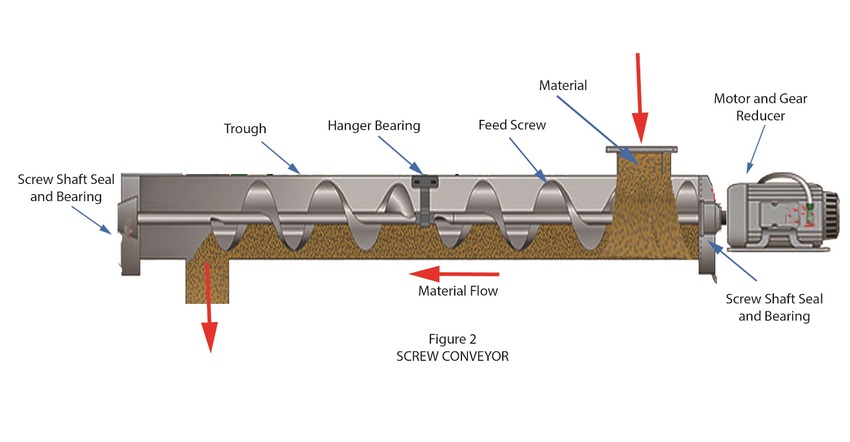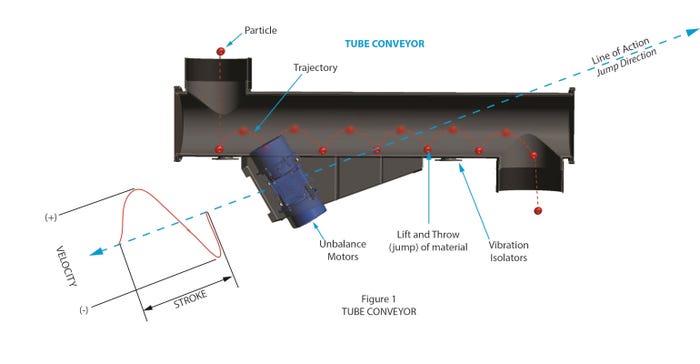Pros and Cons of Vibratory Tube Conveyors and Screw Conveyors
Vibratory tube conveyors and screw conveyors have distinct advantages and disadvantages, making them suitable for different material handling applications.
February 20, 2024

Conveyors play a pivotal role in various industries, facilitating the seamless movement of materials from one point to another. Among the myriad conveyor options available, vibratory tube conveyors and screw conveyors stand out as popular choices. Each type comes with its own set of advantages and disadvantages, catering to specific application needs. In this article, we will delve into a detailed exploration of the pros and cons of vibratory tube conveyors and screw conveyors, aiding readers in making informed decisions based on their unique requirements.
Vibratory Tube Conveyors
Vibratory tube conveyors, also known as vibratory tube conveyors, utilize vibrations to transport bulk materials. The conveyor consists of a tube with an eccentrically mounted drive that imparts vibrations to the material, causing it to move forward in a controlled manner. Let's delve into the advantages and disadvantages of vibratory tube conveyors:

Tube feeder (image courtesy of Vibra Screw Inc.)
Pros of Vibratory Tube Conveyors
Gentle Material Handling
Vibratory tube conveyors excel at handling fragile materials. The gentle vibrations prevent material degradation and breakage, making them suitable for transporting sensitive items like food products and pharmaceuticals.
Customizable Configurations
These conveyors are highly customizable to suit specific applications, with nearly infinite length and diameter to match application requirement. They can handle a wide range of material temperatures from subzero to over 600˚F. Multiple inlets can be accommodated making it easy to work with multiple bins or infeed points. Adjustments in vibrator vibration frequency and amplitude can be made to accommodate various material types and flow rates. Tube conveyors are completely dust tight.
Reduced Maintenance Requirements
Vibratory tube conveyors have fewer moving parts compared to some other conveyor types, leading to reduced maintenance requirements. No bearings or shaft seals are needed. This can result in lower maintenance costs and increased operational efficiency.
Quiet Operation
The vibrations in vibratory tube conveyors are relatively quiet compared to the noise generated by some other conveyor systems. This feature is particularly beneficial in environments where noise levels need to be minimized.
Versatility in Material Types
Vibratory tube conveyors can handle a wide range of materials, including powders, granules, grains, and irregularly shaped items like aggregate that cannot be handled properly with a screw. This versatility makes them suitable for diverse industries, from agriculture to manufacturing.
Cons of Vibratory Tube Conveyors
Limited Capacity
Vibratory tube conveyors may have limitations in terms of conveying capacity and conveying distances compared to some other types of conveyors, especially for high-volume applications. This makes them more suitable for moderate to low-volume material handling.
Material Segregation Potential
In some cases, the vibratory motion can lead to material segregation, especially if the particles have varying sizes and densities and the conveying distance is long. Careful design considerations and testing are required to mitigate this potential issue.
Limited Inclination Capability
Vibratory tube conveyors have limitations in terms of conveying materials over inclined distances. Typically tube conveyors are limited to a 3˚ incline. Other conveyor types, such as screw conveyors, may be more suitable for such applications.
Screw Conveyors
Screw conveyors, also known as auger conveyors, are designed with a rotating helical screw blade to move materials along a trough. These conveyors are widely used in many industries, each with its own set of advantages and disadvantages.
Pros of Screw Conveyors
High Conveying Capacity
Screw conveyors are renowned for their high conveying capacity, making them suitable for handling large volumes of materials. This makes them ideal for industries with high production demands.
Versatility in Configurations
Screw conveyors can be configured in various ways to suit specific applications. They can be designed as horizontal, inclined, or vertical conveyors, providing flexibility in material transport over different terrains.
Effective for Inclined Applications
Screw conveyors are particularly effective in conveying materials over inclined or vertical distances. Their design prevents material from sliding back, making them suitable for applications where elevation changes are required.
Cost-Effective Initial Investment
Screw conveyors often have a lower initial cost compared to some alternative conveyor types. This makes them an attractive choice for budget-conscious industries.
Cons of Screw Conveyors
Maintenance
Screw conveyors are known for their simplicity. However they do require motors, gear reducers, bearings, and seals that wear over time and need replacing. If the application is handling abrasive material the rotating screw can wear excessively if not designed for the application. Wear-resistant steel and coatings can be used to minimize the damage, but these added features can significantly drive up initial cost.
Material Degradation
The rotating screw blades in screw conveyors can cause shear forces on certain materials, potentially leading to material degradation. This makes them less suitable for handling friable materials.
Noise Generation
The rotating screw blades can generate noise during operation, which may be a concern in environments where noise levels need to be minimized.
Bulk Density Sensitivity
Screw conveyors may experience challenges when handling materials with varying bulk densities. Proper design considerations and testing are essential to ensure optimal performance.
Conclusion
In conclusion, both vibratory tube conveyors and screw conveyors have their distinct advantages and disadvantages, making them suitable for different material handling applications. The choice between these two conveyor types ultimately depends on factors such as the type of material being conveyed, the required conveying capacity, environmental considerations, and budget constraints.
Vibratory tube conveyors are well-suited for handling fragile materials with gentle vibrations, providing customization options and reduced maintenance requirements. On the other hand, screw conveyors offer high conveying capacity, versatility in configurations, and cost-effective initial investments, making them suitable for industries with varying needs.
Ultimately, a thorough analysis of the specific material handling requirements and careful consideration of the pros and cons discussed in this article will guide industry professionals in choosing the conveyor system that aligns best with their unique application needs.
Tom Picone is director of business development, Vibra Screw Inc. (Totowa, NJ). For more information, call 973-256-7410 or visit www.vibrascrew.com.
You May Also Like


